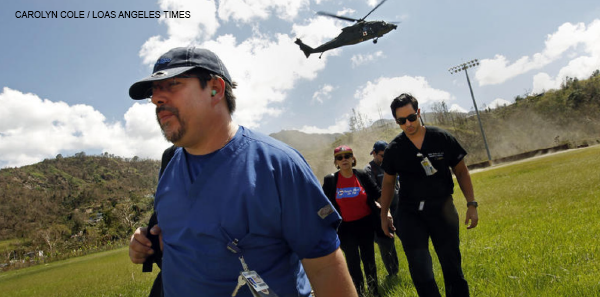

Explore This Issue
ACEP Now: Vol 37 – No 02 – February 2018Dr. Lugo, Dr. Tirado, Dr. Kotler, and Dr. Lopez inside the US Customs and Border Patrol plane that transported the team to Puerto Rico.
PHOTOS: Julian Trivino
The next day, we spent much of our time establishing provisional medical licenses to practice in PR. The PR Department of Health (DOH) had moved its headquarters to the convention center in San Juan; it had become a military fortress. Military personnel with automatic weapons surrounded the building. There we made contact with Norma Torres, the assistant to the secretary of the DOH. Through her, we were granted provisional licenses #001–004. She informed us that a nearby hospital in Aguadilla, which supported the entire northwest corner of the island, was on the brink of closing, and the PR DOH needed personnel to assess the current situation of the hospital and likely stay to work for a few days. Communication lines were down, so updates were being relayed to the DOH by townspeople making their way to San Juan in search of assistance.
At the Hospital
We arrived in Aguadilla the next morning as the sun was rising. The hospital sits adjacent to the ocean, and despite the level of surrounding destruction, it remained a beautiful sight. We were shown to the office of the medical director where hospital leaders were discussing shutting down the hospital within two hours. They were concerned about the lack of diesel fuel and potable water as well as their overworked staff.
As the medical director took us into the emergency department, one of the patients being held there went into cardiac arrest. There was only one physician for 30 beds, and she was busy tending to another critically ill patient. The medical director immediately sprung into action and started CPR. Our team and the remaining staff worked for more than 15 minutes to successfully resuscitate the patient. Within a matter of 10 minutes, we had walked into the emergency department, resuscitated a patient, and established rapport with the staff. Although the emergency department was hemorrhaging morale, our arrival lifted the spirits of nurses, techs, and other physicians who had been praying for help.
The emergency department in Aguadilla had no air-conditioning, and temperatures were 91–97°F at all times. The air was humid and smelled of disease. After just one hour in the emergency department, my scrubs were soaked and sticking to my body. We faced challenges I had never experienced in the United States. The first was managing septic patients with fevers of 103–106°F in a room that was only a few degrees cooler. We were short on antibiotics, normal saline, ice to pack axillas, central lines, and IV tubing. There were no imaging capabilities, only plain radiographs, without a radiologist to read images. To transfer a patient to a trauma center, we had to use our satellite phones and attempt to establish a connection while pointing the antenna to the clearest spot in the sky. With the help of Florida Hospital, within two days, we had a shipment sent on a private plane with many of the needed supplies. In addition to the Florida Hospital shipment, we received aid from the Federal Emergency Management Agency and continued support from PR DOH. After spending three days in Aguadilla, Ms. Torres asked us to return to San Juan for our next mission. They had heard via people coming from Aguadilla that the hospital had been stabilized.
Helping in Other Areas

Dr. Trivino reads a C-spine X-ray while outside the Aguadilla hospital in Puerto Rico.
Julian Trivino
Pages: 1 2 3 | Single Page





No Responses to “An Emergency Medicine Resident’s Journey Through the Devastation of Hurricane Maria”